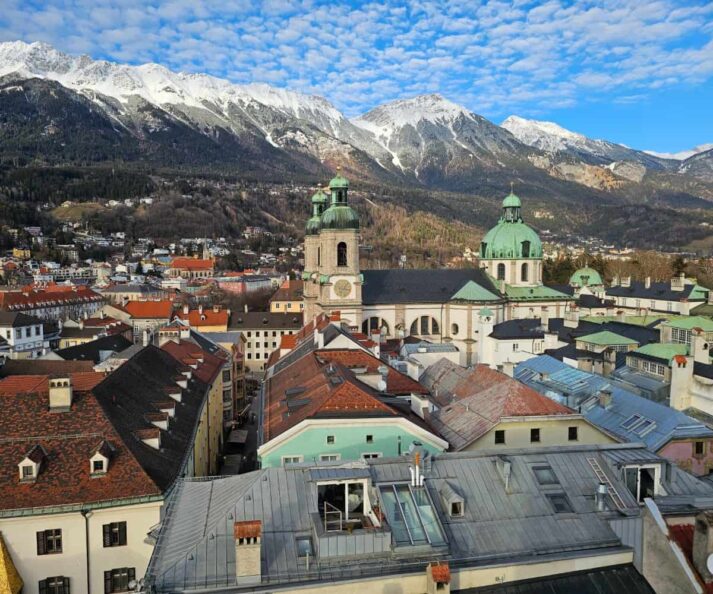Exploring Innsbruck: A Gateway to Alpine Culture and History
Innsbruck, the capital of Tyrol in western Austria, is not only renowned for its stunning alpine landscape but also for its unique cultural heritage and accessibility. A recent arrival at Innsbruck Airport reveals breathtaking views of snow-covered peaks inevitably accompanied by the invigorating mountain air. This picturesque city offers visitors a seamless transition from air travel to urban exploration, making it an ideal destination for travelers seeking a combination of adventure and history.
Effortless Access to City Center
One of the most striking features of Innsbruck is its accessibility. Visitors can reach the city center within 15 to 20 minutes from landing, a rarity among European airports. This is made possible by the F bus service located conveniently outside the airport, which transports passengers directly to Innsbruck Hauptbahnhof (the main train station) where the historic Old Town is easily navigable on foot.
Upon arrival, travelers can enjoy a variety of dining options right in the city center, such as traditional Tyrolean cuisine at local restaurants like Weisses Rössl. For first-time visitors, engaging a private guided tour can greatly enhance the experience, providing valuable insights into the city’s rich history and hidden gems through the eyes of knowledgeable locals. Certified guide Monika highlights the importance of these personal narratives, stating, "Stories and details shared by someone with a deep-rooted connection to the city offer an experience unlike any other."
A Journey Through History and Culture
Innsbruck is a city steeped in history, with intricately wrought-iron signs adorning its streets. These historical markers once served as practical advertisements for merchants before literacy became widespread, melding functionality with artistry. On a guided tour, travelers are led to the panoramic viewpoints that encapsulate the character of Innsbruck, such as a snapshot of the River Inn alongside the brightly colored façades of Mariahilfstrasse, a tradition rooted in the need for identification and now a hallmark of the city’s charm.
The tour also reveals the city’s close relationship with nature, as Monika explains how seasonal snowmelt can cause flooding in the River Inn every spring. This intertwining of urban life with natural elements emphasizes the respect residents hold for their environment—a sentiment mirrored in the vibrant local marketplace that thrives with farmers and vendors every morning.
Iconic Landmarks and Historical Figures
Among Innsbruck’s most recognized landmarks is the Golden Roof, featuring 2,657 fire-gilded tiles. Built by Emperor Maximilian I, this roof symbolizes the city’s historical significance as a former capital of Europe. The area surrounding the Golden Roof is adorned with plaques commemorating notable visitors, including Napoleon Bonaparte and other prominent figures, serving as a reminder of Innsbruck’s influential past.
Monika elaborates on Maximilian’s life and legacy, discussing how his strategic marriages expanded his empire, ultimately leading to a complex history entwined with the Habsburg dynasty. The Hofkirche, housing several impressive statues representing historical figures, stands testament to the architectural and cultural advancements of the Renaissance, with many sculptures surviving even the destruction of World War II.
Resilience and Modernity in Innsbruck
The journey through Innsbruck’s fragments of history encapsulates a spirit of resilience following past disasters, such as the critical fire that prompted efforts to rebuild and modernize, leading to the characteristically domed walkways of the Old Town. Monika expresses pride in the city’s ability to adapt and thrive in the face of challenges, while the infusion of youthful energy from its university and the influence of nearby cultures enriches the local fabric.
As the exploration wraps up at Adlers Hotel, a modern addition to Innsbruck’s skyline, it becomes clear that the city is a seamless blend of historical charm and contemporary vibrancy. Travelers leave with more than a mere understanding of the city; they experience a magnetic pull that often leads them to return.
Conclusion
Innsbruck is an enchanting destination that marries the thrill of adventure with the richness of history and culture. The city’s accessibility, coupled with its remarkable offerings—from enchanting guided tours to stunning natural vistas—makes it a notable stop for any traveler. As visitors explore the intertwining paths of nature and history, they inevitably develop a sense of belonging to this remarkable alpine locale, one that beckons return time and time again.









